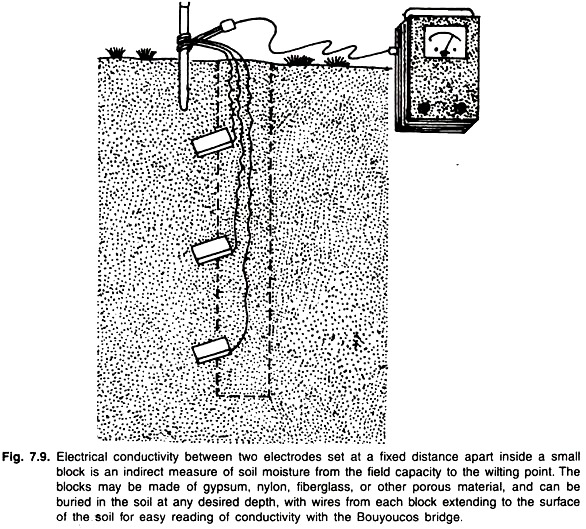ADVERTISEMENTS:
This article throws light upon the top four methods used for the measurement of soil moisture. The methods are: 1. Gravimetric Method 2. Electrical Conductivity Method 3. Measurement by using Tensiometers 4. 4. Neutron Scattering Method.
1. Gravimetric Method:
This method is the classical procedure used as the check for all other methods. A soil is sampled, put into a container, weighed in the sampled (moist) condition, oven dried, and weighed again after drying. Drying is done at 105°-110°C (221°F-230°F) to constant weight (2 hrs. for small samples, but as much as days for bulky clayey soil samples and low airflow in the oven).
The mass water content (θm) is the decimal value that equals the weight of water divided by the weight of oven dried soil.
ADVERTISEMENTS:
The mass water percentage (Pm) is calculated on the basis of dry soil weight using the following formula:
% moisture – weight of moist or wet soil – weight of oven dry soil/weight of oven dry soil × 100
2. Electrical Conductivity Method:
This method is based upon the changes in electrical conductivity with the variation in soil moisture. A gypsum block inside of which are two electrodes at a definite distance apart are used. These gypsum blocks require calibration for uniformity before use.
The blocks are buried in the soil at a desired depth and the conductivity is measured with a modified Wheatstone bridge. Through this method, the percentage of moisture from the field capacity to the wilting percentage can be easily measured.
ADVERTISEMENTS:
The limitation of this method is that it cannot be used in soils containing high salt concentration which interferes during the measurement. This method is practiced in the laboratory (Fig. 7.9).
3. Measurement by using Tensiometers:
Tensiometers measure the matric potential of soil moisture in situ (field) with the use of a porous clay cup attached to a tube filled with water. The water in the cup and tube is attached to a vacuum gauge or a mercury manometer (Fig. 7.10).
As the soil dries, water moves out through the porous cup, creating a suction or vacuum on the water column. These suction readings are then calibrated on the gauge to a specific soil to interpret the per cent of moisture.
Tensiometers can be used to schedule irrigation by placing one instrument at a depth of maximum root density and activity; a second instrument may be placed near the bottom of the active root zone. A need for irrigation could be indicated by a reading or calculation of -500 cm of water (-0.5 bar) for example, for the tensiometer in the active root zone and -400 cm or a little water (-0.4 bar) for the deep tensiometer.
The main limitation of tensiometers is that they do not measure soil matric potential values as low as the usual wilting values. The actual range of effective measurement is only from 0 to -0.85 bars. Tensiometer is useful for measuring moisture in sandy soils than that of clay soils, because of higher matric potentials in the former soils.
4. Neutron Scattering Method:
Neutron probes look like flashlight cylinders with long cords attached (Fig. 7.11). The probe contains radioactive material (radium or beryllium that emits rapidly moving neutrons).
As the neutrons emitted from the probe collide with hydrogen ions (of which water is a major source), they are slowed and deflected, and some of the slowed deflected neutrons are deflected back to the probe where a counter measures them. Only slowed neutrons are counted. The more slowed neutrons that return (indicating large number of collisions), the greater the water content of the soil.
Hysteresis:
An interesting phenomenon occurring when soils are alternately wetted and dried is illustrated below (Fig. 7.12). The upper solid line is termed the desorption curve develops due to drying of a saturated soil.
The lower dotted line is termed the sorption curve develops due to wetting an initially dry soil. The difference between the two curves is due to the phenomenon of hysteresis resulting from the presence of entrapped air in such soil.
Hysteresis phenomenon exists in soil minerals as a consequence of shrinking and swelling. Shrinking and swelling affect pore size on a micro basis as well as on the basis of overall bulk density.
ADVERTISEMENTS:
So hysteresis phenomenon is caused by a number of factors like, shape and size of soil pores and their inter connection with each other, pore configuration, nature of soil colloids including both clay and organic colloids, bulk density of soil and entrapped air etc.
The most important factor affecting hysteresis is the entrapment of air in the soil under rewetting condition. This clogs some pores and prevents effective contact between others. So hysteresis must be taken into consideration in research where much accurate measurement is required.



